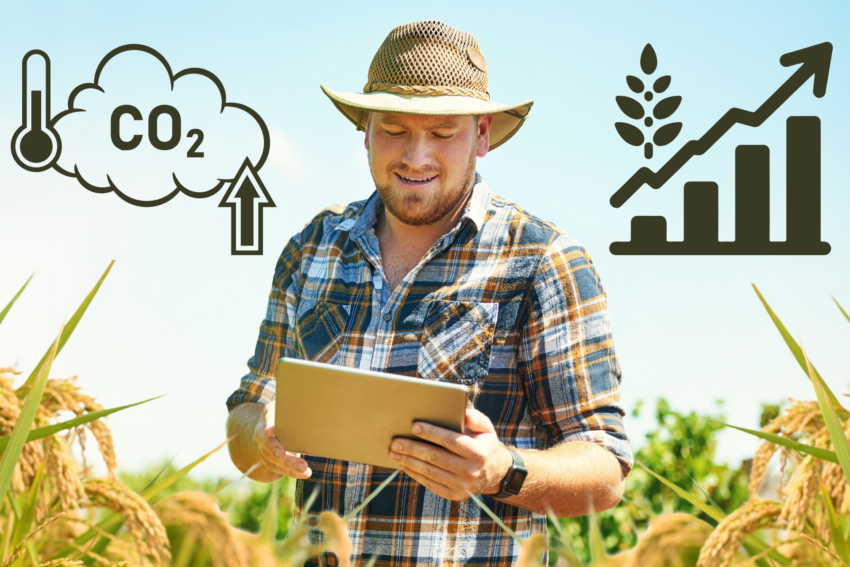In the ongoing debate about climate change, a narrative often overlooked by mainstream media and environmental activists is the potential agricultural benefits that might arise from shifts in climate conditions. While the discourse predominantly focuses on the purported adverse effects of global warming, such as extreme weather events and sea-level rise, and placing a good deal of the blame on agriculture, there’s some irrefutable evidence that “climate change” (as it is presented to us in the mainstream) is advantageous for farming.
Increased CO2 Levels: A Natural Fertilizer
This paper, using real data, indicates that the increase in CO2,caused by human emissions, is the largest single driver in increased crop yield in USA since 1940. Fertilizer would no doubt be #2, well CO2 is a fertilizer!
Genetics would likely be #3.https://t.co/ILHvMqJbfO— Patrick Moore (@EcoSenseNow) May 11, 2023
One of the most straightforward benefits of increased atmospheric CO2 levels is the enhancement of photosynthesis in plants. This phenomenon, known as CO2 fertilization, has been observed to boost plant growth and crop yields significantly. Greenhouses, for instance, artificially increase CO2 levels to improve plant productivity, a practice that mirrors what’s happening on a global scale due to rising CO2 concentrations.
CO2 – Awkies for the narrative …
The increase in C02 increase, however that has occurred, has produced a 20% increase in global greening
AND a 13% global improvement in crop yields, with no additional use of fertiliser.
Bad news for the Climate zealots 🤡 pic.twitter.com/p2c1GJySqk
— Bernie (@Artemisfornow) July 20, 2024
There’s a consensus among some climate scientists and agricultural experts that this increase in CO2 has led to a greener planet, with estimates suggesting a 20% increase in global greening and a 13% improvement in crop yields without additional fertilizers. This natural fertilization effect could be a game-changer for agriculture, potentially leading to higher yields with less input, thereby increasing efficiency and reducing costs for farmers.
Elevated atmospheric [CO2 ] can dramatically increase wheat yields in semi-arid environments and buffer against heat waves & mitigates the effect of surface drought.
Study 1: https://t.co/UGnzd0B205
Study 2: https://t.co/dfSPdhfUUM pic.twitter.com/x740NRkH2K— CO2 Coalition (@CO2Coalition) January 31, 2024
Another great benefit is that increased CO2 makes crops more resistant to drought and high temperatures.
Warmer Temperatures and Extended Growing Seasons
Warmer temperatures, another supposed aspect of climate change, could extend growing seasons in regions previously limited by cold weather. For instance, areas like Florida benefit from multiple growing seasons due to its warmer climate. If global temperatures continue to rise, more regions might experience similar conditions, allowing for multiple harvests per year. This could revolutionize agricultural productivity in temperate zones, where traditionally, only one growing season was feasible. The expansion of thermal suitability for crops like wheat in regions like Russia or Canada could lead to significant agricultural expansion and productivity gains.
Climate change has benefits. Some regions of this planet will see milder climate and better conditions from agriculture. We'll see fewer people freeze to death, and, yes, some plants actually benefit from carbon dioxide.https://t.co/3ZFtjbNApc
— Sabine Hossenfelder (@skdh) June 9, 2024
The Paradox of Climate Change Activism
Interestingly, many of the solutions proposed by climate change activists, such as reducing CO2 emissions, cooling the planet through geoengineering, or even reducing sunlight via solar radiation management, could counteract these agricultural benefits. Lower CO2 levels would reduce the fertilization effect, potentially leading to decreased crop yields. Similarly, cooler temperatures might revert some areas back to single growing seasons, limiting agricultural output. This paradox highlights a critical conflict between environmental goals and agricultural needs, suggesting that what’s considered ‘bad’ for the climate might actually be beneficial for farming.
Record Yields Amidst Climate Change
Despite the frequent warnings about the negative impacts of climate change, agricultural statistics from recent years, especially in the U.S., suggest a different story. Record crop yields have been reported, which could be partially attributed to the very climate changes being decried. This phenomenon indicates that agriculture might be more resilient or even adaptive to these changes than previously thought, or that the benefits in some regions might outweigh the supposed costs.
Conclusion
The discussion around climate change needs to embrace a more nuanced view, acknowledging that while there are challenges to a changing climate, there are also potential benefits, particularly for agriculture. Increased CO2, warmer temperatures, and potentially longer growing seasons could lead to agricultural booms in certain regions. However, this perspective isn’t to dismiss the need for better stewardship of the natural world, reducing pollution, and mitigating the threats posed by extreme weather events. Instead, it calls for a balanced approach in policy-making and public discourse, recognizing that what’s deemed universally harmful might have silver linings, especially in the realm of food production. As we navigate through these changes, understanding and leveraging these benefits could be crucial in ensuring global food security.


